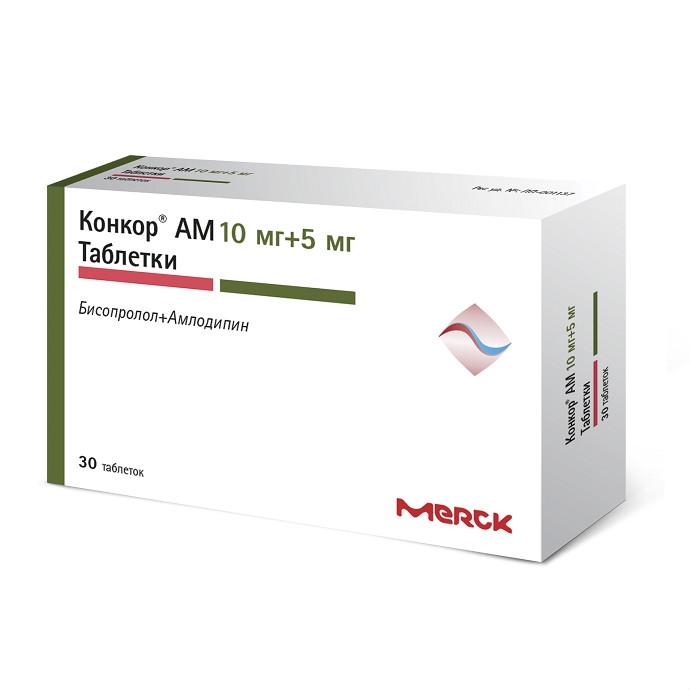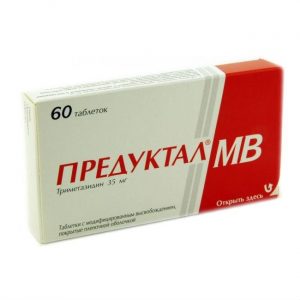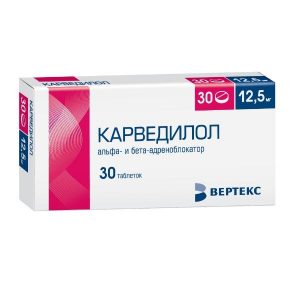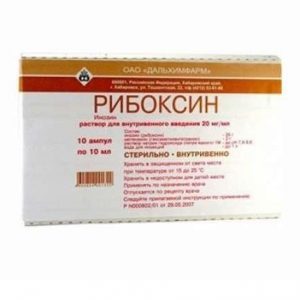Description
Release form
tablets
Packing
30 pcs.
Pharmacological action
Pharmacodynamics
Concor AM has pronounced antihypertensive and antianginal effects due to the complementary effect of two active ingredients: BMKK – amlodipine and selective beta1-blocker – bisoprolol.
Amlodipine mechanism of action:
Amlodipine blocks calcium channels, reduces the transmembrane transition of calcium ions to the cell (more to vascular smooth muscle cells than to cardiomyocytes).
The antihypertensive effect of amlodipine is due to the direct relaxing effect on vascular smooth muscle cells, which leads to a decrease in peripheral vascular resistance.
The mechanism of antianginal action is not fully understood, perhaps it is associated with the following two effects:
Expansion of peripheral arterioles reduces the overall peripheral resistance, i.e. afterload. Since amlodipine does not cause reflex tachycardia, myocardial energy and oxygen consumption is reduced.
The expansion of the large coronary arteries and coronary arterioles improves the oxygen supply of both normal and ischemic myocardial zones. Thanks to these effects, myocardial oxygen supply improves, even with spasm of the coronary arteries (Prinzmetal angina pectoris or unstable angina pectoris).
In patients with arterial hypertension, taking the drug once a day causes a clinically significant decrease in blood pressure in the lying and standing positions throughout the entire 24-hour interval between doses of the drug. Due to the slow development of the antihypertensive effect of amlodipine, it does not cause acute arterial hypotension.
In patients with angina pectoris, taking the drug once a day increases the total exercise time, the time until an angina attack develops, and also the time to a significant reduction in the ST interval, and also reduces the frequency of angina attacks and the need for sublingual nitroglycerin.
No adverse effects of amlodipine on the exchange of plasma lipids, blood glucose and uric acid of blood serum.
Mechanism of action of bisoprolol:
Bisoprolol is a selective beta1-blocker, without its own sympathomimetic activity, does not have a membrane-stabilizing effect.
It has only a slight affinity for beta2-adrenergic receptors of smooth muscles of the bronchi and blood vessels, as well as beta2-adrenergic receptors involved in the regulation of metabolism. Therefore, bisoprolol generally does not affect airway resistance and metabolic processes in which beta2-adrenergic receptors are involved.
The selective effect of the drug on beta1-adrenergic receptors remains outside the therapeutic range.
Bisoprolol does not have a pronounced negative inotropic effect. The maximum effect of the drug is achieved 3-4 hours after ingestion. Even with the appointment of bisoprolol once a day, its therapeutic effect persists for 24 hours due to the 10-12 hour half-life from plasma. Usually, maximum antihypertensive effect is achieved 2 weeks after the start of treatment.
Bisoprolol reduces the activity of the sympathoadrenal system (CAS) by blocking beta1-adrenergic receptors in the heart.
With a single oral administration in patients with coronary heart disease (CHD) without signs of chronic heart failure (CHF), bisoprolol reduces heart rate (HR), reduces stroke volume and, as a result, reduces the ejection fraction and myocardial oxygen demand. With prolonged therapy, initially elevated total peripheral vascular resistance (OPSS) decreases. A decrease in plasma renin activity is considered as one of the components of the hypotensive effect of beta-blockers.
Pharmacokinetics
Amlodipine:
Absorption:
Amlodipine is well absorbed after oral administration. The maximum concentration in the blood plasma is observed after 6-12 hours. Taking the drug with food does not affect its absorption. Absolute bioavailability is 64 – 80%.
Distribution:
The apparent volume of distribution is 21 l / kg. Equilibrium plasma concentration (5-15 ng / ml) is achieved 7-8 days after the start of the drug. In vitro studies have shown that circulating amlodipine is approximately 93-98% bound to plasma proteins.
Metabolism and excretion:
Amlodipine undergoes extensive metabolism in the liver. Approximately 90% of the dose taken is converted to inactive pyridine derivatives. About 10% of the dose taken is excreted unchanged in the urine. Approximately 60% of the amount of inactive metabolites is excreted by the kidneys and 20-25% through the intestines. The decrease in plasma concentration is biphasic. The final half-life is approximately 35-50 hours, which allows the drug to be administered once a day. The total clearance is 7 ml / min / kg (25 l / h in a patient weighing 60 kg). In elderly patients, it is 19 l / h.
In elderly patients and patients with renal failure, no significant changes in the pharmacokinetics of amlodipine were observed.
Due to decreased clearance, patients with hepatic insufficiency should be given a lower initial dose.
Bisoprolol:
Absorption. Bisoprolol is almost completely absorbed (more than 90%) from the gastrointestinal tract. Its bioavailability due to insignificant metabolism at the first passage through the liver (at the level of about 10%) is about 90% after ingestion. Eating does not affect bioavailability. Bisoprolol demonstrates linear kinetics, and its plasma concentrations are proportional to the dose taken in the range from 5 to 20 mg. The maximum concentration in blood plasma is reached after 2-3 hours.
distribution. Bisoprolol is distributed quite widely. The volume of distribution is 3.5 l / kg. Communication with plasma proteins reaches approximately 30%.
Metabolism. It is metabolized via the oxidative pathway without subsequent conjugation. All metabolites are polar (water soluble) and excreted by the kidneys. The main metabolites found in blood plasma and urine do not show pharmacological activity. Data, obtained as a result of experiments with in vitro human liver microsomes, show that bisoprolol is metabolized primarily by the CYP3A4 isoenzyme (about 95%), and the CYP2D6 isoenzyme plays only a minor role.
Withdrawal. Bisoprolol clearance is determined by the equilibrium between excretion by the kidneys unchanged (about 50%) and metabolism in the liver (about 50%) to metabolites that are also excreted by the kidneys. The total clearance is 15 l / h. The elimination half-life is 10-12 hours.
Indications
Arterial hypertension: replacement of therapy with monocomponent preparations of amlodipine and bisoprolol in the same doses.
Contraindications
For amlodipine: unstable angina (except for Prinzmetal angina)
acute myocardial infarction (within the first 28 days)
clinically significant aortic stenosis.
For bisoprolol: acute heart failure or chronic heart failure (CHF) in the decompensation stage, requiring inotropic therapy
atrioventricular (AV) block II and III degree, without pacemaker
sinus node weakness syndrome (SSS)
sinoatrial blockade
severe bradycardia (heart rate less than 60 beats / min)
severe forms of bronchial asthma or chronic obstructive pulmonary disease (COPD)
severe rheumatic syndromes simultaneous use of alpha-blockers)
metabolic acidosis
Amlodipine / bisoprolol combination: hypersensitivity to amlodipine, other derivatives of dihydride ropiridine, bisoprolol and / or any of the excipients
severe arterial hypotension (systolic blood pressure less than 100 mm Hg)
shock (including cardiogenic)
children under 18 years of age (efficacy and safety not established)
Caution
CHF (including non-ischemic etiology of functional class III-IV according to NYHA classification), liver failure, renal failure, hyperthyroidism, diabetes mellitus with significant fluctuations in the concentration of glucose in the blood, AV block I degree, Prinzmetal angina, peripheral arterial occlusion diseases, psoriasis (including history), starvation (strict diet), pheochromocytoma (with the use of alpha-ad enoblokatorov), bronchial asthma and COPD simultaneously conducted desensitizing therapy, general anesthesia, advanced age, hypotension, type 1 diabetes, aortic stenosis, mitral stenosis, acute myocardial infarction (after 28 days).
Use during pregnancy and lactation
Amlodipine:
In experimental studies, the fetotoxic and embryotoxic effects of the drug have not been established, but use during pregnancy is possible only if the benefit to the mother outweighs the potential risk to the fetus.
There is no evidence of excretion of amlodipine in breast milk. However, it is known that other BMCC – derivatives of dihydropyridine, are excreted in breast milk. In this connection, if necessary, the appointment of amlodipine during lactation should decide on the termination of breastfeeding.
For bisoprolol:
The use of bisoprolol during pregnancy is possible only when the intended benefits to the mother outweigh the potential risk to the fetus. Beta-blockers reduce blood flow in the placenta and can affect fetal development. Blood flow in the placenta and uterus should be monitored, as well as the growth and development of the unborn child, and in case of adverse events regarding pregnancy and / or the fetus, take alternative methods of therapy.
The newborn should be carefully examined after childbirth. In the first three days of life, symptoms of bradycardia and hypoglycemia may occur. There is no data on the release of bisoprolol into breast milk. Therefore, its intake is not recommended for women during breastfeeding. If bisoprolol is required during lactation, breast-feeding should be discontinued.
Special instructions
For amlodipine:
Patients with heart failure should take amlodipine with caution. In patients with NYHA stage III-IV heart failure, amlodipine increases the risk of pulmonary edema, which is not associated with exacerbation of symptoms of CHF.
For bisoprolol:
Discontinuation of bisoprolol treatment should not be sudden, especially in patients with coronary artery disease, unless there is a clear indication for drug withdrawal. Sudden withdrawal of bisoprolol can lead to a temporary deterioration of cardiac pathology.
Bisoprolol should be prescribed with extreme caution to patients with arterial hypertension or angina pectoris, combined with heart failure.
As with other beta-blockers, bisoprolol can cause increased sensitivity to allergens and increased anaphylactic reactions, so caution should be exercised with simultaneous desensitizing therapy. The use of adrenaline may not always give the expected therapeutic effect.
When using bisoprolol, symptoms of hyperthyroidism may mask.
In patients with pheochromocytoma, bisoprolol should be prescribed only after blocking alpha-adrenergic receptors.
Before general anesthesia is performed, the anesthetist must be informed that the patient is taking beta-blockers. If beta-blocker must be withdrawn before surgery, this should be done gradually and completed approximately 48 hours before anesthesia.
In bronchial asthma or COPD, the simultaneous use of bronchodilating agents is indicated. In patients with bronchial asthma, an increase in airway resistance is possible, which requires a higher dose of beta2-adrenergic agonists.
Effect on the ability to drive vehicles and mechanisms
During treatment with the drug, care must be taken in driving and working with technically complex mechanisms.
Dosage and administration of
Concor AM tablets for oral administration. Tablets should be taken in the morning, regardless of food intake, without chewing.
Recommended daily dosage is 1 tablet per day for a specific dosage.
Selection and titration of a dose individually for each patient is carried out by a doctor during the appointment of monocomponent preparations containing the active ingredients, which are part of the drug Concor AM.
Duration of treatment
Treatment with Concor AM is usually a long-term therapy.
Impaired liver function
In patients with impaired liver function, amlodipine excretion may be slowed down. A special dosage regimen for this group of patients is not defined, but the drug in this case should be prescribed with caution.
For patients with severely impaired liver function, the maximum daily dose of bisoprolol is 10 mg.
Impaired renal function
Patients with impaired renal function of mild or moderate severity of dosage regimen are usually not required. Amlodipine is not excreted by dialysis. Dialysis patients should be given amlodipine with extreme caution.
For patients with severe renal impairment (creatinine clearance (CC) less than 20 ml / min), the maximum daily dose of bisoprolol is 10 mg.
Elderly patients
Elderly patients may be given normal doses of the drug. Caution is required only with increasing doses.
Children
The drug is not recommended for use in children under the age of 18 due to the lack of data on efficacy and safety.
Treatment should not be abruptly discontinued, as this may lead to a temporary worsening of the clinical condition. Especially treatment should not be abruptly discontinued in patients with coronary artery disease. A gradual dose reduction is recommended.
Side effects of
Undesirable side reactions observed when using the active ingredients separately are presented in accordance with the following criteria for frequency grouping:
Amlodipine: Disorders of the blood and lymphatic system: very rare: leukopenia, thrombocytopenia.
Immune system disorders: very rare: allergic reactions.
Metabolism and nutritional disorders: very rare: hyperglycemia.
Mental disorders: infrequently: insomnia, mood changes (including anxiety), depression rarely: confusion.
Disorders of the nervous system: often: headache, dizziness, drowsiness (especially at the beginning of treatment) infrequently: fainting, hypesthesia, paresthesia, dysgeusia, tremor very rarely: muscle hypertension, peripheral neuropathy.
Disorders of the organ of vision: infrequently: impaired vision (including diplopia).
Hearing impairment and labyrinth disorders: infrequently: tinnitus.
Disorders of the gastrointestinal tract: often: nausea, abdominal pain infrequently: vomiting, change in bowel movement (including constipation or diarrhea), dyspepsia, dry oral mucosa is very rare – gastritis, gingival hyperplasia, pancreatitis.
Disorders of the liver and biliary tract: very rare: hepatitis *, jaundice *.
Disorders from the heart: often: palpitations very rare: myocardial infarction, arrhythmia (bradycardia, ventricular tachycardia, atrial fibrillation).
Vascular disorders: often: flushing of the face, infrequently: marked decrease in blood pressure is very rare: vasculitis.
Disorders of the respiratory system, chest and mediastinal organs: infrequently: shortness of breath, rhinitis very rarely: cough.
Disorders of the kidneys and urinary tract: infrequently: pollakiuria, painful urination, nocturia.
Disorders of the genitals and mammary gland: infrequently: impotence, gynecomastia.
General disorders and disorders at the injection site: often: peripheral edema, increased fatigue infrequently: chest pain, asthenia, pain, general malaise.
Disorders of the musculoskeletal and connective tissue: often: ankle swelling infrequently: arthralgia, myalgia, muscle cramps, back pain.
Disorders of the skin and subcutaneous integument: infrequently: alopecia, purpura, discoloration, increased sweating, itching, rash, exanthema very rarely: angioedema, erythema multiforme, urticaria, exfoliative dermatitis, Stevens-Johnson syndrome photosensitivity.
Laboratory and instrumental data: infrequently: weight gain, weight loss is very rare: increased activity of “liver” enzymes *.
* In most cases with cholestasis
For bisoprolol:
Disorders in the metabolism and nutrition: rarely: increased concentration of triglycerides.
Mental disorders: infrequently: depression seldom: hallucinations, nightmares.
Disorders of the nervous system: often: headache **, dizziness ** infrequently: insomnia rarely: fainting.
Disorders of the organ of vision: rare: decreased lacrimation (should be considered when wearing contact lenses) very rarely: conjunctivitis.
Hearing impairment and labyrinth disorders: rarely: hearing impairment.
Disturbances from the heart: infrequently: violation of AV conduction, bradycardia, aggravation of symptoms of chronic heart failure.
Vascular disorders: often: a feeling of coldness or numbness in the limbs, a marked decrease in blood pressure infrequently: orthostatic hypotension.
Disorders of the respiratory system, chest and mediastinal organs: infrequently: bronchospasm in patients with bronchial asthma or a history of airway obstruction rarely: allergic rhinitis.
Disorders of the gastrointestinal tract: often: nausea, vomiting, diarrhea, constipation.
Disorders of the liver and biliary tract: rarely: hepatitis.
Disorders of the skin and subcutaneous integument: rarely: hypersensitivity reactions such as pruritus, rash, redness of the skin very rarely: alopecia. Beta-blockers can exacerbate the symptoms of psoriasis or cause a psoriasis-like rash.
Violations of the musculoskeletal and connective tissue: infrequently: muscle weakness, muscle cramps.
Disorders of the genitals and mammary gland: rarely: impotence.
General disorders and disorders at the injection site: often: fatigue ** infrequently: exhaustion **.
Laboratory and instrumental data: rarely: increased activity of hepatic transaminases in the blood (aspartate aminotransferase (ACT), alanine aminotransferase (ALT)).
** Especially often, these symptoms appear at the beginning of treatment. Typically, these phenomena are mild and go away, usually within 1-2 weeks after the start of treatment.
Drug interaction
Amlodipine:
Concomitant use of amlodipine with thiazide diuretics, beta-blockers, long-acting nitrates, sublingual nitroglycerin preparations, non-steroidal anti-inflammatory drugs, antibiotics and hypoglycemic agents for oral administration are considered safe.
CYP3A4 Inhibitors: Amlodipine should be used with caution in conjunction with CYP3A4 inhibitors. Although adverse events related to such an interaction were not reported.
Inducers CYP3A4: Concomitant use with inducers of CYP3A4 (including rifampicin, St. John’s wort perforated) can lead to a decrease in the concentration of amlodipine in blood plasma. Amlodipine should be used with caution concurrently with CYP3A4 inducers. Grapefruit juice, cimetidine, aluminum / magnesium (as part of antacids) and sildenafil do not affect the pharmacokinetics of amlodipine.
Amlodipine may enhance the antihypertensive effect of other antihypertensive drugs.
Amlodipine does not affect the pharmacokinetics of atorvastatin, digoxin, ethanol (beverages, containing alcohol), warfarin or cyclosporine.
Amlodipine has no effect on laboratory parameters.
For bisoprolol:
Not recommended combinations
Slow calcium channel blockers (BMKCs) such as verapamil and, to a lesser extent, diltiazem, while using bisoprolol, can lead to a decrease in myocardial contractility, a marked decrease in blood pressure and impaired AV conduction. In particular, intravenous administration of verapamil to patients taking beta-blockers can lead to severe arterial hypotension and AV block.
Central antihypertensive drugs (such as clonidine, methyldopa, moxonidine, rilmenidine), when used together with bisoprolol, can lead to a reduction in heart rate and a decrease in cardiac output, as well as vasodilation due to a decrease in central sympathetic tone. Abrupt withdrawal, especially before the abolition of beta-blockers, may increase the risk of developing “rebound” arterial hypertension.
Combinations requiring caution
BMKK derivatives of dihydropyridine (eg, nifedipine) when used concomitantly with bisoprolol may increase the risk of hypotension. In patients with heart failure, the risk of a subsequent deterioration in cardiac contractile function cannot be ruled out.
Class I antiarrhythmic drugs (e.g., quinidine, disopyramide, lidocaine, phenytoin, flecainide, propafenone), when used together with bisoprolol, can reduce AV conductivity and myocardial contractility.
Class III antiarrhythmic drugs (e.g., amiodarone) may increase impairment of AV conduction.
Parasympathomimetics when used simultaneously with bisoprolol can increase the violation of AV conduction and increase the risk of developing bradycardia.
Topical beta-blockers (for example, eye drops for glaucoma) can enhance the systemic effects of bisoprolol (lowering blood pressure, lowering heart rate).
The hypoglycemic effect of insulin or hypoglycemic agents for oral administration may be enhanced. Signs of hypoglycemia – in particular tachycardia – may be masked. Such interactions are more likely when using non-selective beta-blockers.
General anesthesia medications can weaken reflex tachycardia and increase the risk of developing hypotension (see Special Instructions).
Cardiac glycosides, when used concomitantly with bisoprolol, can lead to an increase in the duration of the pulse and to the development of bradycardia.
Nonsteroidal anti-inflammatory drugs (NSAIDs) may decrease the antihypertensive effect of bisoprolol.
The simultaneous use of bisoprolol with beta-adrenergic agonists (for example, isoprenaline, dobutamine) can lead to a decrease in the effect of both drugs.
The combination of bisoprolol with adrenergic agonists affecting beta and alpha adrenergic receptors (for example, norepinephrine, epinephrine) can enhance the vasoconstrictor effects of these agents that occur with the participation of alpha adrenergic receptors, leading to an increase in blood pressure. Such interactions are more likely when using non-selective beta-blockers.
antihypertensive drugs, as well as other agents with a possible antihypertensive effect (for example, tricyclic antidepressants, barbiturates, phenothiazines) can enhance the antihypertensive effect of bisoprolol.
Combinations that
needs to be considered Mefloquine while used with bisoprolol may increase the risk of developing bradycardia.
MAO inhibitors (with the exception of MAO B inhibitors) may enhance the antihypertensive effect of beta-blockers. Simultaneous use can also lead to the development of a hypertensive crisis.
Rifampicin shortens the half-life (T1 / 2) of bisoprolol slightly. As a rule, dose adjustment is not required.
Ergotamine derivatives when used concomitantly with bisoprolol increase the risk of peripheral circulation disturbance.
Overdose
By amlodipine:
Symptoms: pronounced decrease in blood pressure with possible development of reflex tachycardia and excessive peripheral vasodilation (risk of developing severe and persistent arterial hypotension, including with the development of shock and lethal outcome).
Treatment: gastric lavage, appointment of activated charcoal, maintenance of cardiovascular function, control of cardiac and pulmonary function, elevated limb position, control of circulating blood volume and diuresis. Intensive symptomatic therapy. To restore the tone of the vessels – the use of vasoconstrictor drugs (in the absence of contraindications to their use) to eliminate the effects of calcium channel blockade – intravenous administration of calcium gluconate. Hemodialysis is not effective.
By bisoprolol
Symptoms: AV blockade, pronounced bradycardia, marked BP, bronchospasm, acute heart failure and hypoglycemia. The sensitivity to single administration of a high dose of bisoprolol varies greatly among individual patients, and patients with CHF are likely to be highly sensitive.
Treatment: in the event of an overdose, first of all, it is necessary to discontinue the drug and start supportive symptomatic therapy.
In severe bradycardia: intravenous atropine. If the effect is insufficient, it is possible to enter with caution the positive chronotropic action with caution. Occasional staging of an artificial rhythm driver may be required.
With a marked decrease in blood pressure: intravenous administration of plasma replacement solutions and vasopressor drugs. Glucagon intravenous administration may also be indicated.
For AV blockade: patients should be monitored continuously and receive
treatment with beta-adrenomimetics such as epinephrine. If necessary – production of an artificial rhythm driver.
When exacerbation of the course of CHF: intravenous administration of diuretics, drugs with positive inotropic effect, as well as vasodilators.
In bronchospasm: the appointment of bronchodilators, including beta2-adrenomimetics and / or aminophylline.
In hypoglycemia: intravenous dextrose (glucose).
Bisoprolol practically cannot be dialyzed.
Storage conditions
Do not store above 30 ° C.
Shelf life
3 years.
Active ingredient
A lodipin, Bisoprolol
Terms and conditions
prescription
Possible product names
CONCOR AM 0.01 + 0.005 N30 TABL
Concor AM 10mg + 5mg Tab. X30
CONCOR AM TAB. 10MG + 5MG No. 30
Concor AM tab. 10mg + 5mg N30 Hungary
Concor AM tablets 10 mg + 5 mg 30 pcs.
Merck KGaA, Russia




